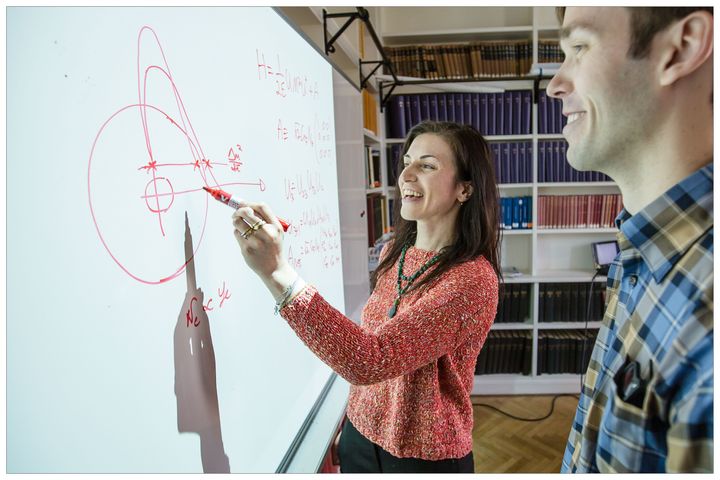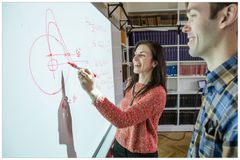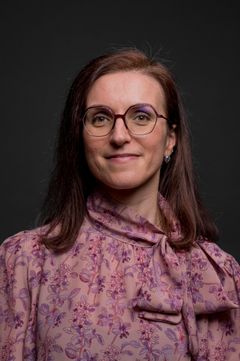Award-winning researcher dreams of stellar explosions and strives for equity and inclusion in academia
She studies the giant explosions of dying stars and dreams of experiencing and extracting data from a supernova close to Earth. Professor Irene Tamborra from the Niels Bohr Institute also tirelessly promotes equity and inclusion in research. Today she receives the prestigious Elite Research Prize and DKK 1.2 million in honor of her research in astrophysics.

"I am fascinated by anything that explodes in the sky," Professor Irene Tamborra says as she begins to describe her research. The professor from the University of Copenhagen’s Niels Bohr Institute finds herself at the top of a list of young, world-class Danish researchers – and is now receiving the Ministry of Higher Education and Science's annual Elite Research Prize.
Professor Tamborra has provided pioneering contributions to an entirely new area of astrophysics known as 'multi-messenger astrophysics'. Since joining the Niels Bohr Institute in 2016, she has established a world-leading group in this new emerging field that studies explosive and energetic events in our Universe, such as supernova explosions, the merger of two neutron stars, and other exotic objects that we are just discovering in the sky.
"To find out what goes on in the core of these energetic cosmic booms, we now have the exciting opportunity to combine photons, neutrinos, and gravitational waves. Just as we humans use all our senses to explore our surroundings, we combine the information carried by these different cosmic messengers to find answers about fascinating astrophysical objects, fundamental physics, and the cosmic origin of the elements making the periodic table," explains Irene Tamborra.
The dream of a stellar explosion in our backyard
As massive stars explode they emit cosmic messengers with enormous power sending clues about the engine powering stellar collapses to researchers.
“The collapse of a massive star, leading to a colossal explosion that can outshine the entire galaxy, results in the emission of neutrinos, photons and gravitational waves that we can detect on Earth. The origin of the atoms in our body can be ultimately traced back to supernova explosions and these cosmic explosions are therefore essential to our life. This is why it is so important to figure out how they work," says Professor Tamborra.
Scientists observed for the first time a supernova in neutrinos in 1987. This stellar collapse occurred very close to the Milky Way, in the Large Magellanic Cloud. At the time, astronomers weren’t equipped with the telescopes and measuring instruments available today. Therefore, one of Tamborra’s greatest dreams is for another supernova to occur close enough to Earth for her research group to learn from it.
"It would be absolutely wonderful because we would be able to measure a million times more particles from the explosion than we could forty years ago and we would be finally able to test our understanding of how these objects work," she says.
Irene Tamborra's discoveries have born groundbreaking new understandings in astrophysics. For example, her research shows that neutrinos – the smallest and second most abundant sub-atomic particles in the universe after photons – play an important role in the physics of supernovae and the merger of two neutron stars, and that these particles can deliver crucial insights from these fascinating cosmic phenomena, which cannot be obtained through electromagnetic radiation.
An inclusive environment in a male-dominated field
In addition to the modeling of cosmic explosions of various types, the researcher is actively engaged in promoting equity and diversity in Academia. It is no secret that there are too few women in STEM fields, but the gender ratio in theoretical (astro) physics is even more skewed. This is a fact that the researcher has experienced firsthand in her own professional trajectory.
"Throughout my career, I've become accustomed to being the only woman in the room, or on the entire floor. It has made me feel out of place, which shouldn’t be the case. Therefore, I try to create an inclusive and welcoming environment in my group, independently of gender, scientific or cultural backgrounds," she says and stresses the upsides in having a diverse research group:
"By having a diverse environment, both with regards to gender and scientific backgrounds, we approach problems differently, which is a huge strength that makes us more creative and encourages more interesting discussions than if we were all alike," concludes Irene Tamborra.
The award will be presented today, 26 February 2024, at 13:00 by H.M. The Queen and the Minister for Higher Education and Science. Read more about the Elite Research Prize here.
More about Irene Tamborra:
Irene Tamborra is Italian. She is Professor at the Niels Bohr Institute, University of Copenhagen, where she leads the Particle Astrophysics group. She is also Mercator Fellow (equivalent of Visiting Professor) at the Max Planck Institutes for Physics and Astrophysics in Garching, Germany.
Irene’s research activity is at the interface between astrophysics and particle physics. Her work focuses on the violent universe, especially on stellar explosions and transient astrophysical events, aiming at unveiling what can be learnt by adopting neutrinos, photons and gravitational waves as probes of the physics of these sources. She is also interested in modeling (quantum) particle transport and particle acceleration in astrophysical outflows, physics beyond the Standard Model, and nucleosynthesis of the heavy elements.
She is the recipient of several international awards for her research, including the MERAC Prize from the European Astronomical Society, the Duggal Award from the International Union of Pure and Applied Physics, and the European Research Council Consolidator Award.
Nøgleord
Kontakter
Irene Tamborra
Professor
Niels Bohr Institute
University of Copenhagen
tamborra@nbi.ku.dk
Michael Skov Jensen
Journalist and team coordinator
The Faculty of Science
University of Copenhagen
msj@science.ku.dk
+ 45 93 56 58 97
Billeder
Følg pressemeddelelser fra Københavns Universitet - Det Natur- og Biovidenskabelige Fakultet
Skriv dig op her, og modtag pressemeddelelser på e-mail. Indtast din e-mail, klik på abonner, og følg instruktionerne i den udsendte e-mail.
Flere pressemeddelelser fra Københavns Universitet - Det Natur- og Biovidenskabelige Fakultet
Farlig type salmonella er stadig ikke nedkæmpet i Danmark – forskere peger på løsningerne30.6.2025 09:54:03 CEST | Pressemeddelelse
Den smitsomme og multiresistente kvægsygdom Salmonella Dublin kan være dødelig for både mennesker og dyr og medfører desuden betydelige tab for landmændene. Selvom Danmark har forsøgt at udrydde sygdommen siden 2008, er det ikke lykkedes. Et studie fra Københavns Universitet peger på den mulige årsag og de nødvendige løsninger.
Her er de blomster som bier og mennesker bedst kan lide27.6.2025 07:12:14 CEST | Pressemeddelelse
Botanikere fra Københavns Universitet og Storbritannien satte sig for at finde de bedste blomsterblandinger til bier og svirrefluer. Resultaterne gør det lettere for bl.a. haveejere og kommuner at plante de perfekte spisekamre for insekterne, som samtidig fryder det menneskelige øje.
Nyt dansk forskningscenter skal skabe designede proteiner med kæmpe potentiale25.6.2025 08:00:00 CEST | Pressemeddelelse
Designede proteiner forventes at få en banebrydende effekt på en lang række områder, fra behandling af sygdomme til håndtering af miljøproblemer. Med en bevilling på 700 mio. kr. fra Novo Nordisk Fonden og under ledelse af professor Dek Woolfson har det nye Center for Protein Design (CPD) på Københavns Universitet ambitioner, der matcher potentialet. CPD vil sætte sig i spidsen for udviklingen af proteindesign og områdets anvendelsesmuligheder gennem tværfagligt samarbejde på Københavns Universitet og partnerskaber i Danmark og udlandet.
New Danish research centre to make designed proteins with vast potential25.6.2025 08:00:00 CEST | Press release
Designed proteins are anticipated to have groundbreaking impact on a range of issues from treating disease to tackling environmental problems. With a DKK 700 million grant from the Novo Nordisk Foundation and headed by Professor Dek Woolfson, a new Center for Protein Design (CPD) at the University of Copenhagen has ambitions to match this potential. The CPD will spearhead developments in protein design and its applications through strong interdisciplinary collaborations across the university and partnerships in Denmark and internationally.
Danmarks ældste datalogiske institut får ny institutleder24.6.2025 10:34:16 CEST | Pressemeddelelse
Lektor Ken Friis Larsen tiltræder fra 1. juli 2025 som institutleder på Datalogisk Institut ved Københavns Universitet (DIKU). Han vil dermed stå i spidsen for at lede et af Europas førende og mest attraktive datalogiske forskningsmiljøer.
I vores nyhedsrum kan du læse alle vores pressemeddelelser, tilgå materiale i form af billeder og dokumenter samt finde vores kontaktoplysninger.
Besøg vores nyhedsrum


